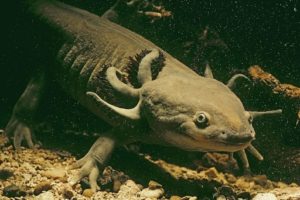We all know that salamanders and newts love to spend a great deal of their time in the water. You may have seen a salamander in a pond or stream and wondered, can salamanders breathe underwater?
Different salamander species have different ways of breathing. Some salamanders, such as axolotls and sirens have gills and can breathe underwater. Others as the tiger salamander, have lungs to breathe air and only have a very limited ability to breathe underwater.
Most salamanders go through three distinct life stages. They begin their lives as tiny larvae with feathery gills. At this stage, they live completely in the water and can breathe underwater using their gills.
After a few months, the larvae go through a process known as metamorphosis to transform into adult salamanders. During this process, they lose their gills and develop strong legs for a life on land.
Adult salamanders that have gone through metamorphosis either have a limited ability to breathe underwater (through their skin) or cannot breathe underwater at all.
Salamanders Have Different Ways of Breathing at Different Stages of Their Life
As I mentioned earlier, the majority of salamanders go through 3 life stages. Female salamanders lay jelly-covered eggs and attach them to vegetation in breeding bonds.
After a few weeks, tiny aquatic larvae emerge from these eggs. These larvae have external feathery gills and live completely in the water, just like frog tadpoles.
Salamander Larvae Can Breathe Underwater
At this stage, salamanders can breathe underwater using their gills. The gills have very thin membranes and a large network of capillaries and other blood vessels. These membranes absorb dissolved oxygen in the water into the bloodstream. Carbon dioxide from the bloodstream also passes through the membranes, into the water.

In this way, larval stage salamanders can breathe underwater, just like fish
Larvae Transform Into Adults
After a few months, the larvae will go through metamorphosis to develop into adults. During this process, the salamander will lose its gills, develop lungs for breathing air, and develop strong legs for walking on land.
Once fully transformed, the salamander will leave the water and live a mostly terrestrial life, only returning to the water to breed.
Some Terrestrial Salamanders Can Breathe Underwater
Adult terrestrial salamanders primarily breathe in two ways: Through their lungs, or their skin.
Some salamanders such as the spotted, and tiger salamander use their lungs to breathe air. Others such as the red salamander, do not have lungs. Instead, they breathe entirely through their skin and thin membranes in their mouth, through a process known as cutaneous respiration. These are called lungless salamanders.
lungless salamanders have moistened skin with very thin permeable membranes. They also have a large network of blood vessels close to the skin surface. The membranes allow oxygen that comes in contact with the moist skin to diffuse into the bloodstream.
At the same time, carbon dioxide from the bloodstream passes through these membranes and is diffused into the atmosphere. This allows lungless salamanders to breathe entirely through their skin and without the use of lungs.
How Terrestrial Salamanders Breathe Underwater
When in the water, terrestrial salamanders can not breathe air. They breathe entirely through their skin. Dissolved oxygen in the water is absorbed through their skin, and into their bloodstream. At the same time, carbon dioxide from the bloodstream passes through their skin and diffuses into the water.
However, this method of breathing does not give them all the oxygen they need, so they can only be underwater for a limited time before they have to resurface for a gulp of air.
Sometimes, Even Adult “Terrestrial” Salamanders Have Gills
Sometimes, normally terrestrial salamanders never go through a metamorphosis as they grow into adults. They retain their gills, and other larval features, and continue to live in the water just like the larvae. This is known as neoteny. It is most common in mole salamanders (tiger salamanders, spotted salamanders, etc).
It mostly happens when the salamander larvae are in a pond with lots of food, making it unnecessary for them to transform into adults and live on land. It can also happen when the conditions on land are hostile, (such as lack of food), making it necessary for the salamanders to remain in the water.

Naturally, neotenic adult salamanders can breathe underwater through their gills, just like the larvae.
How Long Can a Salamander Stay Underwater?
How long a salamander can stay underwater depends on how much oxygen it can absorb from the water.
This is usually down to four factors:
- The temperature
- The nature of the water the salamander is in
- The salamanders’ skin surface area.
- How active the salamander is.
The Temperature
The amount of oxygen in the water will be lower at warmer temperatures, and higher at colder temperatures. Also, salamanders will have a higher rate of metabolism at higher temperatures, meaning they have a greater oxygen demand.
At colder temperatures, the opposite is true. Salamanders will be less active, and have lower rates of metabolism, meaning they have a lower oxygen demand.
All this combined means salamanders will be able to stay underwater at colder temperatures for much longer than they can at warmer temperatures. This is because they will have low oxygen requirements, which they can easily meet in the oxygen-rich water.
The Nature of the Water
Fast-moving water contains more oxygen than stagnant water. This is because oxygen from the atmosphere is dissolved into the water easier. This means salamanders can say underwater in fast-moving water for much longer than they can in still or stagnant pools of water.
For this reason, salamanders such as the hellbender prefer to live in cold, fast-flowing streams where they can absorb lots of oxygen from the water.
The Salamanders’ Skin Surface Area
Salamander larvae and most aquatic adult salamanders have feathery gills that provide a large surface area. This allows lots of lots oxygen from the water to be absorbed into the bloodstream. However, adult terrestrial salamanders only have a limited skin surface area, which limits the amount of oxygen they can absorb through their skin.
For this reason, most adult terrestrial salamanders can only stay underwater for a very limited time before they have to resurface for air.

Some salamanders such as the hellbender, have very wrinkled skin. This means their skin has a bigger surface area to absorb oxygen from the water. For this reason, hellbenders can stay underwater for an indefinite period.
How Active the Salamander Is
Activity affects how much oxygen the body needs. Think about it, when we are running or jogging, we breathe heavier and in much quicker breaths than when we are at rest.
For salamanders, this is also true. They will have a higher oxygen demand when they are very active in the water (escaping a predator or chasing prey, for example), and a lower oxygen demand when they are inactive.
This means terrestrial salamanders can stay underwater when at rest, for much longer than they can when they are very active.
Can a Salamander Drown?
Even with their ability to breathe underwater through their skin, salamanders can drown. If a salamander stays in water with low oxygen for too long or gets into water so deep that it can not get out, it can drown.
Also, certain illnesses and skin conditions can affect how much oxygen a salamander can absorb through its skin.
Frequently Asked Questions
Question: Can Newts Breathe Underwater
Answer: Newts, just like salamanders can breathe underwater by absorbing oxygen that comes in contact with their skin. Their skin has a large network of blood vessels, that allow oxygen in the water to diffuse directly into their bloodstream.
Much like salamanders, they can only stay underwater for a limited time before they have to resurface. But aquatic newts can stay underwater for a very long time.
Question: Do Salamanders Lay Eggs?
Answer: Most salamander species lay eggs. However, some salamanders, such as the alpine and fire salamander, give birth to live young.
In these salamanders, eggs develop and hatch in the salamander’s body. The larvae then grow until they look like miniature versions of the adult salamanders. The mother salamander then gives birth to these tiny salamanders.
Conclusion
Salamanders are amphibians, so they are always either aquatic (they live in water), or semi-aquatic (they live both in the water and on land). In both of these environments, they have unique ways of breathing. Aquatic salamanders either have feathery gills or very wrinkly skin with a large surface area. This helps them absorb lots of oxygen from the water.
Terrestrial salamanders on the other hand, either have lungs or breathe entirely through their skin. Still even these, have a limited ability to breathe underwater through their skin.
If you have a pet salamander, it’s important to educate yourself on the specific housing requirements of your pet. Some salamanders will be fine with deep water, while others will drown without a sufficient land area.
Provide your salamander with the most appropriate habitat! Remember, salamanders can drown, even with their ability to breathe underwater.

